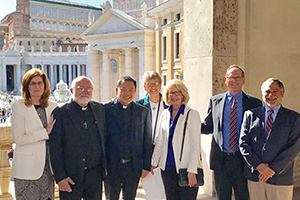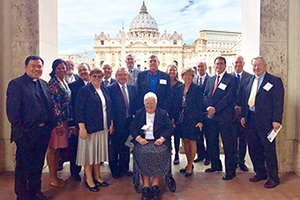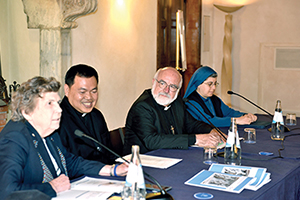By JULIE MINDA
Separated by an ocean, a six-hour or greater time difference and language barriers, it might have been very difficult for the pioneer public ministerial sponsors of Catholic health care in the U.S. to build rapport with Vatican officials to whom they report.
But a tradition of in-person meetings at the Vatican established about two decades ago by the first U.S. ministerial juridic person — and carried on by the MJPs formed since then — is proving extremely valuable for building important bonds between the U.S. MJPs and the Roman Curia.
That is according to several ministry leaders connected with U.S. sponsor bodies that report on the fidelity to Catholic identity and mission of their ministries to a dicastery, the Congregation for Institutes of Consecrated Life and Societies of Apostolic Life. The MJPs are responsible for continuing the viability of the health care ministry and animating its work.

In early May, a PeaceHealth delegation made an in-person progress report to the Congregation for Institutes of Consecrated Life and Apostolic Life in Vatican City. Shown from left are Liz Dunne, PeaceHealth's president and chief executive officer; dicastery staffers Fr. Hank Lemoncelli, OMI, and Fr. Elias Ayuban, CMF; Sr. Andrea Nenzel, CSJP, chair of the PeaceHealth Board of Directors; Carol Aaron, PeaceHealth executive vice president and chief administrative officer; and board members Dr. Todd Strumwasser and Karl Carrier.
The face-to-face meetings with representatives of the dicastery "are an important way of 'friend-raising' and getting to know the people you're accountable to (from the sponsors' perspective) and accountable for (from the Vatican's perspective)," says canon lawyer Sr. Peggy Ann Martin, OP, senior vice president of sponsorship and governance for Englewood, Colo.-based Catholic Health Initiatives. "You need to have that relationship — that trust level — and to know who to go to" when needs arise.
Leap of faith
CHI was the first U.S. Catholic health system to employ the ministerial juridic person structure for sponsorship, in large part to have a more flexible model for incorporating many different sponsoring congregations as well as laity into a single sponsoring body. Traditionally sponsor boards have been comprised of vowed religious; but in response to the call of Vatican II for more lay inclusion, and also as the population of sisters declines, more ministries have sought the flexibility to commission lay sponsors.
The Vatican approved the Catholic Health Care Federation as the ministerial juridic person of a predecessor of CHI in 1991 and then approved it as sponsor of all of CHI's ministries when CHI was established in 1996.
Since then, the Vatican has approved more than two dozen MJP bodies around the world, with most of them in health care.
Canon lawyer Sr. Kelly Connors, pm, former CHA senior director of sponsor services, is a general councilor for the Sisters of Presentation of Mary of the United States Province. She says while the statutes of most MJPs require them to regularly submit written reports to the dicastery — the dicastery has said the reports should come annually or every other year depending on the MJPs' longevity — there is no such mandate for in-person visits.
It is extremely rare for the dicastery representatives to visit the U.S., and they almost never visit individual U.S. health systems due to the vastness of the global ministry. So MJP members who wish to meet with the dicastery staff make the trip to Rome.
Sr. Connors says the Vatican has welcomed the visits.
For an institution with a centuries-long history, the 26-year-old MJP model is still very new. "The model is expanding, so the Holy See wants to understand it well and ensure it's implemented well and keep a close eye on how it's working."
Face time
Speaking to Catholic Health World recently about their MJPs' meetings with the dicastery were CHI's Sr. Martin; Sr. Barbara Hagedorn, SC, chair of CHI's MJP; David Lincoln, president and chief executive of Covenant Health of Tewksbury, Mass., and head of its MJP, Covenant Health Systems; Rosanne Ponzetti, system vice president, mission services, for PeaceHealth of Vancouver, Wash.; Sr. Barbara Schamber, SP, president of Providence Ministries, the MJP of Providence Health & Services; and Eleanor V. Brewer, chair of St. Joseph Health Ministry, the MJP of St. Joseph Health. (Providence and St. Joseph have combined to form Providence St. Joseph Health; but each organization has retained its own MJP.)

Against a backdrop of St. Peter's Basilica, top executives of Covenant Health of Tewksbury, Mass., members of its ministerial juridic person and representatives of the Congregation for Institutes of Consecrated Life and Societies of Apostolic Life gather for a photo following an October 2016 meeting.
Generally, MJPs that value in-person meetings send delegations to the Vatican every two to five years. The meetings take place at the offices of the dicastery, which is housed in a stately stone building with a balcony overlooking St. Peter's Square.
It is common for about a dozen-plus people from the MJP to take part, including the MJP's members, topmost health system executives and mission staff executives. While representation from the Vatican has varied over time, it is usual in recent years for Fr. Hank Lemoncelli, OMI; Fr. Elias Ayuban, CMF; other dicastery staff and an interpreter to be present. Fr. Lemoncelli is the American representative of the Vatican office; and Fr. Ayuban is a key dicastery contact for the MJPs. Often, Brazilian Cardinal João Braz de Aviz, the prefect of the dicastery, will join. The session usually lasts about an hour.
CHA members say the meetings usually include presentations by the MJP members and health system leaders about the particulars of how their MJP furthers the work of the church, aids the poor and vulnerable, forms leaders and sponsors in the charisms of the founding congregations and in Catholic identity. Presenters may describe how their health ministry approaches challenges and issues inherent in providing faith-based care in a secular health care economy. The meetings also include a question-and-answer segment led by the Vatican representatives and informal dialogue.
Several ministry members say the meeting structure has grown less formal as relationships have developed.
Welcoming atmosphere
Sr. Schamber of Providence Ministries attributes the warming to the influence of Pope Francis, who was elected Pope in 2013, and Cardinal Braz de Aviz, who assumed leadership of the dicastery in 2011. "The tone (of the meetings) noticeably changed for me. It has been more free-flowing and congenial and very welcoming. There is a totally different camaraderie," says Sr. Schamber.
Catholic Health Care Federation's Sr. Hagedorn notes that in recent years, there's much more dialogue and evidence of mutual trust in the meetings. The Vatican emissaries are very engaged and interested in learning about the MJP and Catholic health care in the U.S., she says.

Sr. Carol Keehan, DC, left, CHA president and chief executive officer, introduces dicastery representatives during a panel discussion at the Vatican. It was part of CHA's 2017 Ecclesiology and Spiritual Renewal Program for Health Care Leaders. Pictured from left to right are Fr. Elias Ayuban, CMF, Fr. Hank Lemoncelli, OMI, and Sr. Annunziata Remossi, OMVI.
Covenant's Lincoln says the dicastery representatives are very attentive to anecdotes about people touched by Catholic health care.
St. Joseph Health Ministry's Brewer says the Vatican representatives show great enthusiasm, "taking notes like crazy."
Sr. Martin says that when Cardinal Braz de Aviz has participated in dicastery meetings with CHI's MJP, he's expressed a sincere appreciation for the contributions of the laity to MJPs and to the church.
Behind the curtain
For Covenant's MJP members, the meetings have been "powerful" and "reenergizing," Lincoln says, adding, "For us, it's also been demystifying. We've grown up thinking there's this vast enterprise called the Vatican, but you go there and see it's good people working for the church, just as we are. It changes the dynamic to put a face to the office" and it gives sponsors and health system representatives the opportunity to better understand the Vatican perspective on the U.S. health ministry.
That demystification works both ways, as information shared in the visits allows the dicastery to gain confidence in the MJP model. Brewer says the dicastery representatives have "given us a lot of positive comments on our work — they said (their office) once had fears about MJPs, but they've since been reassured."
PeaceHealth's Ponzetti says the Vatican office representatives are "very appreciative of all that the ministries are doing, particularly for the poor."
Lincoln says, "We get a powerful positive message from the dicastery. I wish everyone could go. It's a real boost."
|
Sponsors invest much time, effort into written reports to Vatican
Members of ministerial juridic persons place much importance on the regular written reports they send to the Congregation for Institutes of Consecrated Life and Societies of Apostolic Life.

Each year PeaceHealth submits an annual report to the Congregation for Institutes of Consecrated Life and Societies of Apostolic Life. A delegation of senior leaders from PeaceHealth hand delivered the report pictured above this spring. Photo by Ken Mayo
The reports describe the works of the MJPs and the systems they sponsor. They include biographical information and photos of the MJPs' members and details on how the organizations are living out their Catholic identity. The reports explain how MJPs and health systems form sponsors and leaders. They detail how systems are providing community benefit, aiding the poor and vulnerable and addressing moral and ethical challenges.
The reports normally are between a dozen and several dozen pages long. Some of the reports are artistically appealing, with elegant graphics and beautiful photographs. Reports may include anecdotes to illustrate important concepts and contain addendums with financial information. Many reports use a storytelling component to illustrate how lives are changed for the better by Catholic health care in the U.S.
While PeaceHealth of Vancouver, Wash., is not mandated to file a report with the Vatican because of the structure of its juridic person, it has chosen to provide the dicastery with a report annually. The most recent report, an 18-page booklet sealed with a stamp imprinted with the system's dove logo, is packaged in an embossed slipcase, or protective cover. Narrative about PeaceHealth's work is interspersed with stories and photos of people impacted by that work. Vellum-like translucent overlay sheets bookend the report, showcasing the beauty of nature in the health system's Pacific Northwest service area. Mission-focused content imprinted on the adjoining pages appears through the overlay.
Rosanne Ponzetti, PeaceHealth system vice president, mission services, says, "Each year our report has gotten better, with more stories and examples of the mission in action."
David Lincoln, president and chief executive of Covenant Health of Tewksbury, Mass., and head of its MJP, notes that the dicastery has given MJPs that have been in existence for five years or longer — Covenant included — the choice to submit their written report every other year, rather than annually like the newer MJPs. But, Lincoln says, Covenant has chosen to continue reporting annually because producing the report has proven to be an important vehicle for communicating to the Vatican about the work of the system and its MJP.
Providence Ministries has given CHW permission to share excerpts from two of its reports to the Congregation for Institutes of Consecrated Life and Societies of Apostolic Life. Here are portions of those reports.
2015 Report
2016 Report
|
|
Dicastery meetings serve as centerpiece for formation opportunities, exploration
Trips to the Vatican by delegations representing U.S. ministerial juridic persons often include formative experiences, education and spiritual retreats.
Some sponsoring bodies schedule their visits to the Congregation for Institutes of Consecrated Life and Societies of Apostolic Life to coincide with CHA's annual Ecclesiology and Spiritual Renewal Program For Health Care Leaders, a week-long learning and renewal program for Catholic health care executives.
That invitation-only CHA program includes meetings with Vatican leaders; a general papal audience in St. Peter's Square; a pilgrimage to Assisi, Italy, the home of Saints Francis and Clare; and formative presentations by CHA staff, among other activities. PeaceHealth of Vancouver, Wash.; and Providence Ministries, the ministerial juridic person of Providence Health & Services, are sponsor organizations that have paired their dicastery visits with CHA's program.
Catholic Health Initiatives' MJP, the Catholic Health Care Federation of Englewood, Colo., develops its own programming around its dicastery visits. Sr. Peggy Ann Martin, OP, senior vice president of sponsorship and governance for CHI, said past groups have added on trips to European sites of historical significance to the health system's founding congregations. One group went to Ireland, to visit sites connected to Sisters of Mercy foundress Catherine McAuley, an Irish laywoman who launched the congregation and its ministry in Dublin.
Covenant Health Systems, the MJP of Covenant Health of Tewksbury, Mass., also creates its own programming, to position its dicastery visits as part of a pilgrimage, says David Lincoln, president and chief executive of Covenant Health and head of its MJP. Sponsors get the opportunity to learn more about the how the Vatican works as well as delve deeper into the spirituality and mission of Catholic health care. The trip typically includes a visit to Assisi.
Saint Francis founded the Franciscan order in the 1200s, and his protégé Saint Clare founded the Poor Clares. Women and men religious from those orders traveled from Europe to the U.S., in part to provide health care to the young nation. Their foundational work led to the founding of hospitals, health systems, long-term care facilities and other health care ministries.
|
Copyright © 2017 by the Catholic Health Association
of the United States
For reprint permission, contact Betty Crosby or call (314) 253-3490.